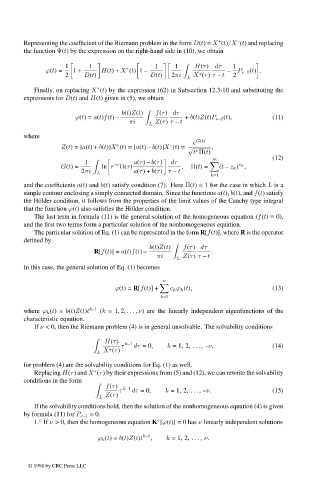Page 656 - Handbook Of Integral Equations
P. 656
+
–
Representing the coefficient of the Riemann problem in the form D(t)= X (t)/X (t) and replacing
the function Ψ(t) by the expression on the right-hand side in (10), we obtain
1 1 + 1 1 H(τ) dτ 1
ϕ(t)= 1+ H(t)+ X (t) 1 – – P ν–1 (t) .
+
2 D(t) D(t) 2πi L X (τ) τ – t 2
+
Finally, on replacing X (t) by the expression (62) in Subsection 12.3-10 and substituting the
expressions for D(t) and H(t) given in (5), we obtain
b(t)Z(t) f(τ) dτ
ϕ(t)= a(t)f(t) – + b(t)Z(t)P ν–1 (t), (11)
πi Z(τ) τ – t
L
where
e G(t)
+ –
Z(t)=[a(t)+ b(t)]X (t)=[a(t) – b(t)]X (t)= √ ,
ν
t Π(t)
m (12)
1 –ν a(τ) – b(τ) dτ
G(t)= ln τ Π(τ) , Π(t)= (t – z k ) ,
ν k
2πi a(τ)+ b(τ) τ – t
L
k=1
and the coefficients a(t) and b(t) satisfy condition (7). Here Π(t) ≡ 1 for the case in which L is a
simple contour enclosing a simply connected domain. Since the functions a(t), b(t), and f(t) satisfy
the H¨ older condition, it follows from the properties of the limit values of the Cauchy type integral
that the function ϕ(t) also satisfies the H¨ older condition.
The last term in formula (11) is the general solution of the homogeneous equation (f(t) ≡ 0),
and the first two terms form a particular solution of the nonhomogeneous equation.
The particular solution of Eq. (1) can be represented in the form R[f(t)], where R is the operator
defined by
b(t)Z(t) f(τ) dτ
R[f(t)] = a(t)f(t) – .
πi Z(τ) τ – t
L
In this case, the general solution of Eq. (1) becomes
ν
ϕ(t)= R[f(t)] + c k ϕ k (t), (13)
k=1
where ϕ k (t)= b(t)Z(t)t k–1 (k =1, 2, ... , ν) are the linearly independent eigenfunctions of the
characteristic equation.
If ν < 0, then the Riemann problem (4) is in general unsolvable. The solvability conditions
H(τ) k–1
τ dτ =0, k =1, 2, ... , –ν, (14)
+
X (τ)
L
for problem (4) are the solvability conditions for Eq. (1) as well.
+
Replacing H(τ) and X (τ) by their expressions from (5) and (12), we can rewrite the solvability
conditions in the form
f(τ) k–1
τ dτ =0, k =1, 2, ... , –ν. (15)
Z(τ)
L
If the solvability conditions hold, then the solution of the nonhomogeneous equation (4) is given
by formula (11) for P ν–1 ≡ 0.
◦
◦
1. If ν > 0, then the homogeneous equation K [ϕ(t)] = 0 has ν linearly independent solutions
ϕ k (t)= b(t)Z(t)t k–1 , k =1, 2, ... , ν.
© 1998 by CRC Press LLC
© 1998 by CRC Press LLC
Page 639

